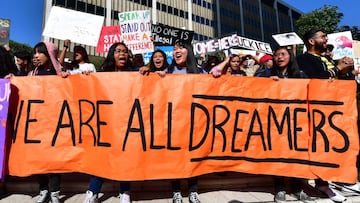What is DACA and how has it protected children?
DACA is once again under attack, bringing back into focus the vulnerable position of undocumented people who arrived to the US as children.

Immigration reform has been a talking point for politicians of both major political parties for over two decades. However, very little legislation was written in that period to fix the country’s broken immigration system. Caught in the middle of this inaction are Dreamers: undocumented individuals of all ages who were brought to the US as children.
The Deferred Action for Childhood Arrivals, or DACA as it is more commonly known, is an immigration policy that aims to protect Dreamers from being deported. Dreamers are active members of society; for many, the US is the only country they have ever known. While DACA does not protect children but rather adults who migrated as children, the Center for American Progress found that the average Dreamers protected under DACA “arrived in the United States in 1999, at age 7,” with more than a third arriving before the age of five.
The origins of DACA
President Barack Obama used his executive authority to begin the program in July 2012. Through executive order, he allowed those eligible to be protected from deportation and given the right to work in the US for two years. After the two years, individuals were able to reapply. To receive the benefit, that applicant must undergo an extensive background check, which must be completed each time the applicant renews their DACA status.
Who was able to apply for protection under DACA?
Applicants had to:
- be sixteen or younger when they arrived;
- be younger than thirty-one when President Obama signed the Executive Order; and
- have lived in the United States since 2007.
The fight over DACA
In 2017, President Trump ended the DACA program, denying any new applicants the opportunity to apply for protection. At the time, U.S. Citizenship and Immigration Services published a report showing that there were around 689,800 DACA recipients in the US, of which forty-five percent resided in California and Texas. Almost eighty percent had come to the United States as children from Mexico. During the announcement, President Trump said that although he did not “favor punishing children, most of whom are now adults, for the actions of their parents,” the country must remember “that we are a nation of opportunity because we are a nation of laws.”
In 2020, the Supreme Court ruled that the Trump administration violated Constitutional law by ending the program. In the 5-4 decision, Chief Justice John Roberts joined the four liberal justices to rule that the administration had not provided sufficient evidence to justify ending the program. Even in Justice Kavanaugh’s dissent, he acknowledged that the uncertainty faced by DACA receipts stems from “Congress’s inability thus far to agree on legislation, which in turn has forced successive administrations to improvise, thereby triggering many rounds of relentless litigation with the prospect of more litigation to come.”
In December 2020, a US District Judge ordered the Department of Homeland Security to begin accepting applications. Further bolstering the program, President Biden signed a Presential Memorandum to reinstate the program on his first day in office. The executive order mandated that the Department of Homeland Security defer the removal of “certain undocumented immigrants who were brought to the United States as children, have obeyed the law, and stayed in school or enlisted in the military.”
Without legal protections from Congress, the fate of Dreamers and other immigrants fell into limbo, and quickly, a federal district court judge used that legal vulnerability to limit the program. In 2021, a federal district judge in Texas, Andrew Hanen, ruled that the program was unconstitutional, barring new applicants from applying for DACA but allowing the protections to remain in place for those who had already had their status approved. President Biden described the court’s ruling as “disappointing,” a word he also used when speaking about the inability of Congress to create a legal path to citizenship for immigrants brought to the US as children. After the ruling, the Biden administration, through the Department of Homeland Security, instituted a new rule that protected the rights of DACA recipients.
On 13 September, the same judge ruled that the way the rule was implemented violated the Administrative Procedure Act, arguing that the way the DACA protections were codified into federal regulation did not abide by the correct process. However, this will not impact any DACA recipients.
A Data for Progress poll conducted in 2022 found that support for DACA among most Democrats and independents remained strong. While a majority of Republicans do not support a pathway to citizenship for dreams, around forty-three percent do, showing that the proposal holds fairly widespread favorability.






